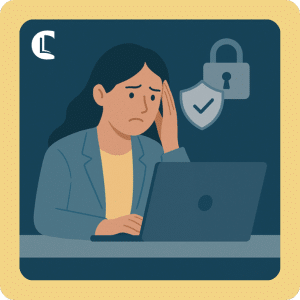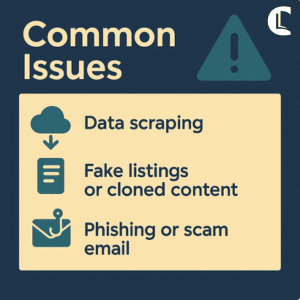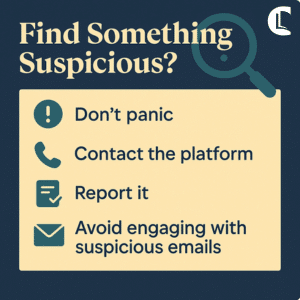As a counsellor, you are encouraged to be visible. Clients need to find you, professional bodies and registers list you, and you may well choose to build an online presence through websites and social media. Your details, e.g. your name, email address and telephone number, may therefore appear on multiple platforms.
But with visibility comes vulnerability – and in some cases, your information may be collected without your consent and then misused. For example, it might appear somewhere you never intended, or what you think is a proper listing might link to another site altogether. The British Association for Counselling and Psychotherapy (BACP) provides examples of various recent scams, and the National Counselling and Psychotherapy Society (NCPS) regularly publishes blog posts to warn people about new scams.
This guide offers a straightforward overview of:
- the risks
- what to look out for
- how to protect your professional identity online.
Your Free Handout
Protecting Your Digital Identity
Why It Matters
Your digital identity is part of your professional boundaries. Yet you may well, at some point, experience boundary breaches such as:
- unsolicited emails offering subscriptions to marketing, directories and search-engine optimisation (SEO) services
- fake or duplicate listings that use your name, profile and information on other websites
- your email address being caught up in data leaks.
Even if nothing serious happens as a result of such breaches, they can feel invasive and erode the clarity you’ve worked hard to create between your personal and professional life.
Common Issues
- Data scraping: Public directories and websites can be ‘scraped’ by bots (automated tools that collect email addresses, telephone numbers and profiles). The resulting data is often sold to third parties or used for cold outreach (where companies approach potential customers who haven’t expressed interest in their products/services).
- Fake listings or cloned content: You might discover versions of your profile on unknown platforms, sometimes even with altered contact details. These platforms don’t always offer a clear and straightforward process for you to get the information removed.
- Phishing or scam email: You might receive emails that purport to be from clients, therapy platforms or even professional bodies. These may include suspicious links or urgent requests for info.
What You Can Do
- Search for yourself online regularly: Google your name with keywords such as ‘counsellor’, ‘therapist’ and your town/city. Check the results carefully, looking at whether the sites are familiar, whether your contact details are correct, and whether anything has been misused. If you find something unexpected, take a screenshot, contact the platform, and ask for removal or correction.
- Use a dedicated work email: Set up a separate email purely for your therapy work, so that you don’t need to use a personal address on public profiles.
- Secure your website: If you run a website, keep your domain registration information private (your web host can do this) and check that your SSL certificate (in effect, your digital ID) is valid (look for the padlock in your browser).
- Consider contact methods on your website: Use a contact form instead of an email address if you can. However, if you do include your email address, format it as ‘hello [at] yourdomain [dot] com’ to make it harder to scrape.
- Enable two-factor authentication (2FA): Wherever it’s offered (e.g. by email providers, online directories and social-media platforms), turn on 2FA. This adds an extra layer of security even if your password is compromised.
- Check for data leaks: Use haveibeenpwned.com to see if your email has appeared in a breach. If it has, change your passwords immediately.
- Keep a list of where you’re listed: Places to which you’ve submitted your information might include directories, membership bodies’ websites and supervisor registers. Do keep a list of these, to make it easier to spot whether there has been any kind of boundary breach.
Finding Something Suspicious
If you do find something suspicious, then the following checklist may be helpful:
- Don’t panic: Take screenshots for your records.
- Contact the platform: Ask for the erroneous content to be removed or corrected, as appropriate.
- Report it: If someone is impersonating you, inform your professional body (for example, the BACP and the Information Commissioner’s Office (ICO, the authority responsible for enforcing data protection laws).
- Avoid engaging with suspicious emails: Instead, mark them as spam. And if they claim to be from an organisation you know, contact the organisation directly (rather than replying to the email).
Free Handout Download
Protecting Your Digital Identity
Frequently Asked Questions
What are the main risks to a counsellor’s professional digital identity?Counsellors face risks such as data scraping by bots, fake or cloned online listings with incorrect contact details, phishing emails impersonating professional bodies or platforms, and unintended exposure of personal email addresses through public directories.
How can I find and remove false or misleading online profiles?Regularly google your own name alongside terms like “counsellor” or your location to locate any unfamiliar listings. If you spot a suspicious profile, capture a screenshot and contact the host site to request correction or removal.
What simple digital steps help maintain professional boundaries online?Use a dedicated work email (ideally hidden from scraping), protect your website with SSL and private domain registration, and consider using a contact form instead of publishing your email, instead formatting it like “hello [at] domain [dot] com” to deter automated harvesting.
In conclusion, protecting your digital identity isn’t about ‘hiding’ – it’s about maintaining the same clarity and professionalism online as you do in the therapy room. Boundaries apply digitally too. A quick monthly check can save hours of difficulties and worry later. And if something doesn’t feel right, trust your instinct.
💡 About Counselling Tutor
Counselling Tutor provides trusted resources for counselling students and qualified practitioners. Our expert-led articles, study guides, and CPD resources are designed to support your growth, confidence, and professional development.
👉 Meet the team behind Counselling Tutor
Notice any broken link or issues with this resource? Kindly let us know by email
Email us

